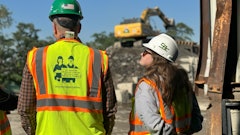
The construction industry is grappling with an unprecedented labor crisis. Despite construction spending being at an all-time high, the U.S. labor force is currently missing over half a million workers needed to build essential housing and upgrade our nation’s infrastructure. This shortage is exacerbated by an aging workforce and a lack of new entrants into the industry, particularly from underrepresented groups such as women.
Today, women make up a mere 11% of the construction industry. When it comes to skilled trades, this number plummets by almost three times: women represent just 4% of the US workforce.
Women constitute over half of the U.S. population: there is an immense, untapped potential to mitigate the labor crisis by actively recruiting more women into the construction industry.
This shift would not only address the workforce gap but also offer women across the country access to higher wages. Construction has the highest industry average hourly earnings for workers without a bachelor’s degree and is among the top in gender pay equity.
This article covers the nationwide initiatives paving the way, as well as the most effective strategies construction companies can implement to attract more women into the industry. The faster we can multiply these, the faster we’ll solve the labor crisis we’re facing.
Initiatives Leading the Way
There are inspiring initiatives being run all over the U.S. by groups ranging from trade associations to local governments.
Groups such as Chicago Women in Trades offer free training programs with robust curriculums that prepare women to build careers in the manufacturing, welding, and metalworking trades.
National organizations such as the National Association of Women in Construction run leadership academies and scholarship programs to help remove barriers to women entering and progressing in the construction industry.
In Maine, Governor Mills signed an Executive Order to improve the recruitment, training, and retention of women in Maine’s construction industry. In California, the Los Angeles metro launched a website dedicated to giving women information about joining apprenticeship readiness training programs. In Arizona, the Arizona Builders Alliance runs a Women in Leadership program to support continued advancement in leadership.
Now, it is our collective responsibility to ensure we increase the number of these initiatives.
The most impactful strategies for companies to pursue
Across the 500+ trade contractors we work with, these strategies have proven most effective in attracting more women into the construction industry:
1. Run targeted recruitment campaigns
Run targeted online recruitment campaigns that are focused on highlighting the opportunities available across the industry. Showcase successful women within construction companies, share their career progression stories, and emphasize the range of jobs available across field and office teams.
In general, recruitment efforts at many construction companies suffer when potential employees can’t see that the industry is for them. This can be because it seems outdated, or simply because they don’t see people like them in the roles they’d be hired into. The more companies can show candidates that they’ll use modern tools, learn transferable skills, and solve challenging and rewarding problems, the more successful their recruiting efforts. If companies can put their female employees at the forefront of these efforts, women will more easily see themselves in the open roles.
2. Partner with educational institutions
Form partnerships with high schools, vocational schools, and universities to increase the exposure to careers in construction. Offering scholarships, internships, and apprenticeships specifically for women, as well as hosting targeted workshops and career fairs, are powerful ways to expand the candidate pool.
3. Invest in training and development
Following the CHIPS Women in Construction Framework, create pathways such as training investments, apprentice utilization goals, and apprenticeship readiness programs. Offering increased technical, leadership, and safety training can help position the construction industry as being more proactive in investing in women.
 @Sandro Amato - adobe.stock.com
@Sandro Amato - adobe.stock.com
4. Create a supportive work environment
Provide on-site childcare, flexible working hours, and robust anti-harassment policies to create a more welcoming environment. Other initiatives we’ve seen work well include creating mentorship programs where experienced female employees mentor new recruits, as well as promoting gender diversity in leadership positions.
5. Sign the Million Women in Construction Community Pledge
In May, the U.S. Department of Commerce launched the “Million Women in Construction Community Pledge” to encourage leading construction companies to demonstrate ongoing commitment to increasing women’s access to training, jobs, and leadership opportunities.
Signing a pledge is just the beginning, but it’s an important step in making the entire company aware that fixing the gender ratio in construction is something that matters.
Leading companies including Suffolk Construction, Power Design, Gilbane Building Company, and Turner Construction have already signed the pledge and begun running targeted recruitment, training, and mentorship programs for women.
Why This Needs to be a Top Priority
The U.S. is on the verge of a major transformation.
We’re reshoring manufacturing so we can make our supply chains more resilient. We’re electrifying our infrastructure so we don’t have to rely as much on fossil fuels. We’re upgrading our grid system so we can handle increased demand for electricity. We’re building more homes to reduce our 1.5 million home deficit. We’re building data centers to power innovation and advancements in AI which are needed for us to maintain our global leadership position.
The timely completion of all of these is crucial, and it requires more workers. Taking the electrical industry as an example: current forecasts show we’ll need over 80,000 more electricians entering the industry per year over the next 10 years to keep up with expected demand.
This moment in time requires us to invest heavily in developing our workforce. Governments, trade organizations, construction companies, and industry groups have to work together to ensure we successfully attract groups who have historically been more hesitant to consider a career in construction into the industry. The biggest of those groups is women.
By empowering women to enter and grow within the construction industry, we’ll unlock a tremendously powerful force in helping us build more, faster.





















